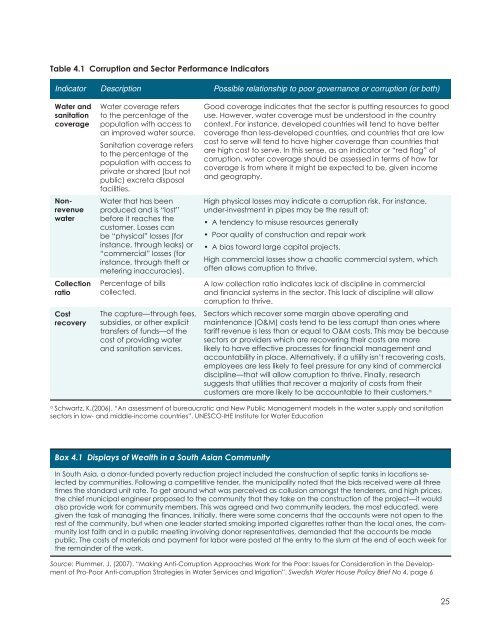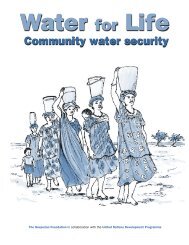A Sourcebook - UN-Water
A Sourcebook - UN-Water
A Sourcebook - UN-Water
Create successful ePaper yourself
Turn your PDF publications into a flip-book with our unique Google optimized e-Paper software.
Table 4.1 Corruption and Sector Performance Indicators<br />
Indicator Description Possible relationship to poor governance or corruption (or both)<br />
<strong>Water</strong> and<br />
sanitation<br />
coverage<br />
Nonrevenue<br />
water<br />
Collection<br />
ratio<br />
Cost<br />
recovery<br />
<strong>Water</strong> coverage refers<br />
to the percentage of the<br />
population with access to<br />
an improved water source.<br />
Sanitation coverage refers<br />
to the percentage of the<br />
population with access to<br />
private or shared (but not<br />
public) excreta disposal<br />
facilities.<br />
<strong>Water</strong> that has been<br />
produced and is “lost”<br />
before it reaches the<br />
customer. Losses can<br />
be “physical” losses (for<br />
instance, through leaks) or<br />
“commercial” losses (for<br />
instance, through theft or<br />
metering inaccuracies).<br />
Percentage of bills<br />
collected.<br />
The capture—through fees,<br />
subsidies, or other explicit<br />
transfers of funds—of the<br />
cost of providing water<br />
and sanitation services.<br />
Good coverage indicates that the sector is putting resources to good<br />
use. However, water coverage must be understood in the country<br />
context. For instance, developed countries will tend to have better<br />
coverage than less-developed countries, and countries that are low<br />
cost to serve will tend to have higher coverage than countries that<br />
are high cost to serve. In this sense, as an indicator or “red flag” of<br />
corruption, water coverage should be assessed in terms of how far<br />
coverage is from where it might be expected to be, given income<br />
and geography.<br />
High physical losses may indicate a corruption risk. For instance,<br />
under-investment in pipes may be the result of:<br />
• A tendency to misuse resources generally<br />
• Poor quality of construction and repair work<br />
• A bias toward large capital projects.<br />
High commercial losses show a chaotic commercial system, which<br />
often allows corruption to thrive.<br />
A low collection ratio indicates lack of discipline in commercial<br />
and financial systems in the sector. This lack of discipline will allow<br />
corruption to thrive.<br />
Sectors which recover some margin above operating and<br />
maintenance (O&M) costs tend to be less corrupt than ones where<br />
tariff revenue is less than or equal to O&M costs. This may be because<br />
sectors or providers which are recovering their costs are more<br />
likely to have effective processes for financial management and<br />
accountability in place. Alternatively, if a utility isn’t recovering costs,<br />
employees are less likely to feel pressure for any kind of commercial<br />
discipline—that will allow corruption to thrive. Finally, research<br />
suggests that utilities that recover a majority of costs from their<br />
customers are more likely to be accountable to their customers. a<br />
a<br />
Schwartz, K.(2006). “An assessment of bureaucratic and New Public Management models in the water supply and sanitation<br />
sectors in low- and middle-income countries”. <strong>UN</strong>ESCO-IHE Institute for <strong>Water</strong> Education<br />
Box 4.1 Displays of Wealth in a South Asian Community<br />
In South Asia, a donor-funded poverty reduction project included the construction of septic tanks in locations selected<br />
by communities. Following a competitive tender, the municipality noted that the bids received were all three<br />
times the standard unit rate. To get around what was perceived as collusion amongst the tenderers, and high prices,<br />
the chief municipal engineer proposed to the community that they take on the construction of the project—it would<br />
also provide work for community members. This was agreed and two community leaders, the most educated, were<br />
given the task of managing the finances. Initially, there were some concerns that the accounts were not open to the<br />
rest of the community, but when one leader started smoking imported cigarettes rather than the local ones, the community<br />
lost faith and in a public meeting involving donor representatives, demanded that the accounts be made<br />
public. The costs of materials and payment for labor were posted at the entry to the slum at the end of each week for<br />
the remainder of the work.<br />
Source: Plummer, J. (2007). “Making Anti-Corruption Approaches Work for the Poor: Issues for Consideration in the Development<br />
of Pro-Poor Anti-corruption Strategies in <strong>Water</strong> Services and Irrigation”. Swedish <strong>Water</strong> House Policy Brief No 4, page 6<br />
25
















